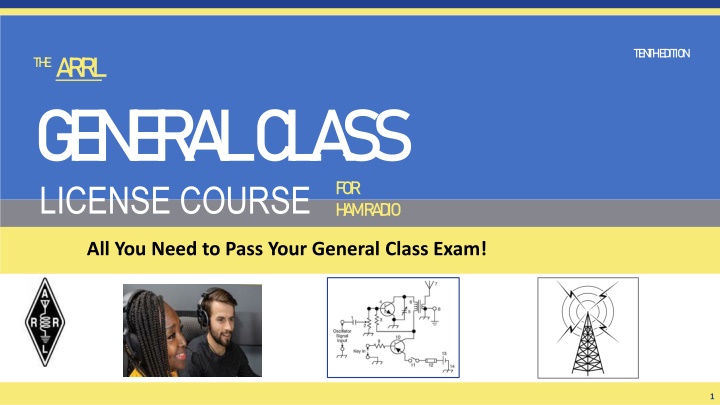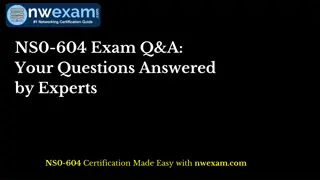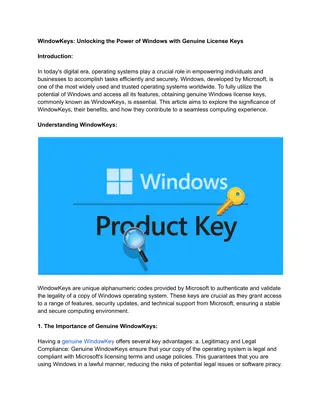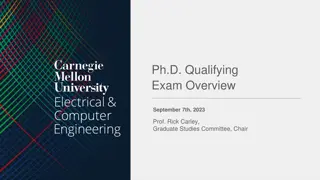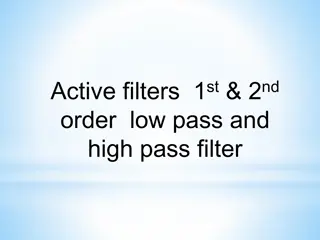General Class License Course: All You Need to Pass Your Exam!
Prepare for your General Class exam with this comprehensive course covering topics such as the ionosphere and propagation. Understand the layers of the ionosphere, the behavior of radio waves, and the reflection process. Enhance your knowledge to successfully pass your General Class exam with confidence.
Download Presentation

Please find below an Image/Link to download the presentation.
The content on the website is provided AS IS for your information and personal use only. It may not be sold, licensed, or shared on other websites without obtaining consent from the author.If you encounter any issues during the download, it is possible that the publisher has removed the file from their server.
You are allowed to download the files provided on this website for personal or commercial use, subject to the condition that they are used lawfully. All files are the property of their respective owners.
The content on the website is provided AS IS for your information and personal use only. It may not be sold, licensed, or shared on other websites without obtaining consent from the author.
E N D
Presentation Transcript
TE N TH E D ITION TH EA RRL G E N E R A L C L A SS LICENSE COURSE FOR H A M R A D IO All You Need to Pass Your General Class Exam! 1
Resource & Reference www.arrl.org/shop/Licensing-Education-and-Training 2
Chapter 8 Part 1 of 1 ARRL General Class Propagation Sections 8.1, 8.2, 8.3 The Ionosphere, The Sun, Scatter Modes 3
Section 8.1 The Ionosphere Upper reaches of atmosphere gets thinner with distance Beginning at about 30 miles, remaining gas is thin enough for ionization to occur This region of the atmosphere becomes a very weak conductor 4
Ionosphere (cont.) D layer (30 to 60 miles in altitude) is only present when illuminated by the sun Disappears at night because ions and free electrons are close enough together to recombine quickly when no UV is present, returning to a neutral condition At night, the D and E regions disappear and the F1 and F2 regions combine to form a single F region Figure 8.1 The ionosphere consists of several regions of ionized particles at different heights above the Earth. 5
Ionosphere (cont.) E layer (60 to 70 miles in altitude) acts similarly to D Higher and less dense than D region, enables it to last longer after sunset F layer (100 to 300 miles in altitude), least dense of the three Remains partially ionized at night During the day, F region splits into F1 and F2 Height of the F region varies quite a bit with local time, season, latitude, and solar activity At any particular location, the stronger the illumination from the sun, the higher the F2 layer will be, so its maximum height is reached at noon when the sun is overhead 6
Reflection Ionosphere refracts radio waves (it s a weak conductor) Refraction amount depends on amount of ionization and wave frequency The HIGHER the ionization, the more the refraction The LOWER the frequency, the more the refraction HF signals relatively good refraction REFLECTED back to the Earth s surface VHF & UHF signals essentially no refraction See Figure 8.2 Each reflection is a hop;allows signal to be received hundreds or thousands of miles away (called skywave; propagation via the ionosphere is called skip) 7
Reflection (cont.) The higher the region from which the reflection takes place, the longer the hop Waves reflected from F2 layer travel up to 2,500 miles before returning to ground Hops from E layer are shorter, up to 1,200 miles, because of lower reflecting height Some combinations of frequency and ionization level result in weak bending wave must leave the Earth s surface at a low enough angle for the bending of the wave to send it back Highest takeoff angle at which a wave can be returned to Earth is the critical angle Critical angle depends on ionospheric conditions and frequency 8
Critical Angle Highest takeoff angle at which a wave can be returned to Earth Critical frequency: Highest frequency on which a wave transmitted straight up will be returned to Earth. 9
Absorption Enemy of propagation is absorption In D and E regions, waves passing through the denser gas are partially absorbed (D region is not very good at refraction) In HF bands below 10 MHz, AM broadcast bands, and at lower frequencies, the D region completely absorbs radio waves during the day, preventing those waves from returning to Earth Absorption increases in daytime and when solar UV is more intense QUESTION: When is the best time to transmit on HF below 10 MHz? Answer: At night! 10
Noise Noise is another enemy of propagation (covers up weak signals) Stronger at frequencies below VHF (due to atmospheric disturbances) Lower you go in frequency, the stronger the noise or static Varies seasonally Most noticeable on lower frequency HF bands in the summer when atmospheric noise is strongest 11
Long Path and Short Path When ionosphere along short path does not support propagation, sometimes long path will Occasionally, propagation over both long and short paths will be supported (at same time) Unless the paths are almost equal there will be an echo (delayed signal arrives a fraction of a second later) Round-the-worldpropagation: you can hear your own signal coming all the way around to your location about 1/7 of a second later! 25,000 miles divided by 186,000 miles/sec This sketch of the Earth shows both great circle paths drawn between two stations. The bearings for the short path and the long path are shown from the Northern Hemisphere station. 12
How is a directional antenna pointed when making a long-path contact with another station? A. Toward the rising sun B. Along the grayline C. 180 degrees from the station s short-path heading D. Toward the north G2D06 (C) Page 8-6 14
What is a characteristic of skywave signals arriving at your location by both short-path and longpath propagation? A. Periodic fading approximately every 10 seconds B. Signal strength increased by 3 dB C. The signal might be cancelled causing severe attenuation D. A slightly delayed echo might be heard G3B01 (D) Page 8-6 15
What is the approximate maximum distance along the Earths surface normally covered in one hop using the F2 region? A. 180 miles B. 1,200 miles C. 2,500 miles D. 12,000 miles G3B09 (C) Page 8-5 16
What is the approximate maximum distance along the Earths surface normally covered in one hop using the E region? A. 180 miles B. 1,200 miles C. 2,500 miles D. 12,000 miles G3B10 (B) Page 8-5 17
Which ionospheric region is closest to the surface of Earth? A. The D region B. The E region C. The F1 region D. The F2 region G3C01 (A) Page 8-2 18
What is meant by the term critical frequency at a given incidence angle? A. The highest frequency which is refracted back to Earth B. The lowest frequency which is refracted back to Earth C. The frequency at which the signal-to-noise ratio approaches unity D. The frequency at which the signal-to-noise ratio is 6 dB G3C02 (A) Page 8-5 19
Why is skip propagation via the F2 region longer than that via the other ionospheric regions? A. Because it is the densest B. Because of the Doppler effect C. Because it is the highest D. Because of temperature inversions G3C03 (C) Page 8-5 20
What does the term critical angle mean, as applied to radio wave propagation? A. The long path azimuth of a distant station B. The short path azimuth of a distant station C. The lowest takeoff angle that will return a radio wave to Earth under specific ionospheric conditions D. The highest takeoff angle that will return a radio wave to Earth under specific ionospheric conditions G3C04 (D) Page 8-5 21
Why is long-distance communication on the 40-, 60-, 80-, and 160-meter bands more difficult during the day? A. The F region absorbs signals at these frequencies during daylight hours B. The F region is unstable during daylight hours C. The D region absorbs signals at these frequencies during daylight hours D. The E region is unstable during daylight ho G3C05 (C) Page 8-5 22
Which ionospheric region is the most absorbent of signals below 10 MHz during daylight hours? A. The F2 region B. The F1 region C. The E region D. The D region G3C11 (D) Page 8-5 23
Section 8.2: The Sun Sunspots and Cycles Ionosphere is dependent on solar UV to separate electrons from atoms Much of the variation in UV radiation is due to sunspot activity One complete sunspot cycle lasts about 11 years When more sunspots are observed, more UV is being generated, creating more intense ionization and improving propagation on higher frequency bands above 10 MHz and even into lower VHF range This graph shows the monthly mean sunspot numbers for several past cycles through October 2018. The NASA Solar Physics web page maintains complete data on the sunspot cycle. In mid 2023, when this book is being published, Cycle 25 is heating up and propagation on 10 meters and other bands is increasing. 24
Sunspots and Cycles (cont.) At peak of cycle, there may be sufficient solar UV to cause higher frequency bands (10 meters) to stay open for long-distance contacts at night High ionization negatively impacts low frequency bands (80 and 160 m) because it increases absorption When solar activity is low, lower HF bands have good propagation and higher HF bands above 20 MHz (15 m and up) are often closed One band that seems to do well at all times in sunspot cycle is 20 meters (14 MHz), supporting daytime communications worldwide nearly every day 25
Table 8.1: Daytime/Nighttime HF Propagation HF BAND (m) DAYTIME NIGHTTIME 160, 80, 60 Local and regional to 100 200 miles Local to long distance with DX best near sunset or sunrise at one or both ends of the contact 40, 30 Local and regional to 300 400 miles Short-range (20 or 30 miles) and medium distances (150 miles) to worldwide 20, 17 Regional to long distance, opening at or near sunrise and closing at night 20 meters is often open to the west at night and may be open 24 hours a day 15, 12, 10 Primarily long distance (1000 miles and more), opening to the east after sunrise and to the west in the afternoon 10 meters is often used for local communications 24 hours a day Sunspots also seem to move across the sun s surface because the sun rotates once every 28 days. That is why propagation conditions (good and bad) on the HF bands often repeat themselves in 28-day cycles as sunspots rotate back into view from Earth. 26
Measuring Solar Activity Solar activity is so important to propagation and communications that it is monitored constantly by solar observatories worldwide Sunspot Number: See Fig 8.6 Solar-Flux Index (SFI): Describes amount of 2800 MHz ( = 10.7 cm) radio energy. Higher levels indicate higher solar activity and better HF propagation above 10 MHz (Fig 8.6) K-index: Values from 0 to 9 represent the short-term stability of the Earth s magnetic or geomagnetic field. Higher values indicate geomagnetic field is disturbed, which disrupts HF. A-index: Gives a good picture of long-term geomagnetic field stability. Ranges from 0 (stable) to 400 (greatly disturbed). Calculated from K-index. 27
How does a higher sunspot number affect HF propagation? A. Higher sunspot numbers generally indicate a greater probability of good propagation at higher frequencies B. Lower sunspot numbers generally indicate greater probability of sporadic E propagation C. A zero sunspot number indicates that radio propagation is not possible on any band D. A zero sunspot number indicates undisturbed conditions G3A01 (A) Page 8-8 29
Which of the following are least reliable for long-distance communications during periods of low solar activity? A. 80 meters and 160 meters B. 60 meters and 40 meters C. 30 meters and 20 meters D. 15 meters, 12 meters, and 10 meters G3A04 (D) Page 8-8 30
What is the solar flux index? A. A measure of the highest frequency that is useful for ionospheric propagation between two points on Earth B. A count of sunspots that is adjusted for solar emissions C. Another name for the American sunspot number D. A measure of solar radiation at 10.7 centimeters wavelength G3A05 (D) Page 8-9 31
At what point in the solar cycle does the 20-meter band usually support worldwide propagation during daylight hours? A. At the summer solstice B. Only at the maximum point of the solar cycle C. Only at the minimum point of the solar cycle D. At any point in the solar cycle G3A07 (D) Page 8-8 32
What causes HF propagation conditions to vary periodically in a 26- to 28-day cycle? A. Long term oscillations in the upper atmosphere B. Cyclic variation in Earth s radiation belts C. Rotation of the Sun s surface layers around its axis D. The position of the Moon in its orbit G3A10 (C) Page 8-8 33
What does the K-index measure? A. The relative position of sunspots on the surface of the Sun B. The short-term stability of Earth s geomagnetic field C. The short-term stability of the Sun s magnetic field D. The solar radio flux at Boulder, Colorado G3A12 (B) Page 8-9 34
What does the A-index measure? A. The relative position of sunspots on the surface of the Sun B. The amount of polarization of the Sun s electric field C. The long-term stability of Earth s geomagnetic field D. The solar radio flux at Boulder, Colorado G3A13 (C) Page 8-9 35
Which of the following is typical of the lower HF frequencies during the summer? A. Poor propagation at any time of day B. World-wide propagation during daylight hours C. Heavy distortion on signals due to photon absorption D. High levels of atmospheric noise or static G3B12 (D) Page 8-8 36
Assessing Propagation MUF: Maximum usable frequency. Highest frequency at which propagation exists between two points. LUF: Lowest usable frequency. Waves below the LUF will be completely absorbed by the ionosphere. MUF & LUF depend on specific path between two points location and distance apart Varies with time of day, season, amount of solar radiation, and ionospheric stability Operating near MUF often gives excellent results; absorption is lowest just below it One way to check actual band conditions is to listen for propagation beacons; some provide real- time propagation information Many stations between 28.190 and 28.225 MHz that are excellent sources of information about 10-meter propagation To make contact with a distant station, you will have to use a frequency between LUF and MUF so the wave is bent back to Earth but isn t absorbed If MUF drops below LUF, then no propagation exists between those two points via ordinary skywave 37
Solar Disturbances Figure 8.7 Approximately eight minutes after a solar flare occurs on the sun, the ultraviolet and X-ray radiation released by the flare reaches the Earth. This radiation causes increased ionization and radio wave absorption in the D region. 38
Solar Disturbances (cont.) Solar flare: A large eruption of energy and solar material when magnetic field disruptions occur on the surface of the sun. Coronal hole: A weak area in the sun s corona (the outer layer) through which plasma (ionized gas and charged particles) escapes the sun s magnetic field and streams away into space at high velocities. Coronal mass ejection (CME): An ejection of large amounts of material from the corona. All of these disrupt HF propagation 39
Sudden Ionospheric Disturbances UV and X-ray radiation from a solar flare travels at speed of light to impact the ionosphere about 8 minutes later When radiation hits the ionosphere, the level of ionization increases rapidly, particularly in D region This increases absorption dramatically, causing a sudden ionospheric disturbance (SID) also known as a radio blackout Lower bands are more strongly affected, but communication may still be possible on a higher band SIDs affect only the sunlit side of the Earth; dark-side communications may be relatively unaffected 40
Geomagnetic Disturbances Interaction between solar wind and geomagnetic field creates a region of space called the magnetosphere Charged particles from coronal holes and coronal mass ejections travel considerably slower and take longer to reach Earth (15 to 40 hours) These particles deposit their energy into Earth s geomagnetic field and increase ionization in E region, causing auroral displays and creating a geomagnetic storm affects higher HF bands first Long-distance paths that traverse high latitudes, particularly those that pass near the magnetic poles, may be completely wiped out for hours to days Can create auroras that reflect radio waves above 20 MHz Auroral propagation is strongest on 6 and 2 m, modulating the signals with a hiss or buzz 41
What effect does a sudden ionospheric disturbance have on the daytime ionospheric propagation? A. It enhances propagation on all HF frequencies B. It disrupts signals on lower frequencies more than those on higher frequencies C. It disrupts communications via satellite more than direct communications D. None, because only areas on the night side of the Earth are affected G3A02 (B) Page 8-12 43
Approximately how long does it take the increased ultraviolet and X-ray radiation from solar flares to affect radio propagation on Earth? A. 28 days B. 1 to 2 hours C. 8 minutes D. 20 to 40 hours G3A03 (C) Page 8-11 44
What is a geomagnetic storm? A. A sudden drop in the solar flux index B. A thunderstorm that affects radio propagation C. Ripples in the geomagnetic force D. A temporary disturbance in Earth s geomagnetic field G3A06 (D) Page 8-12 45
How can a geomagnetic storm affect HF propagation? A. Improve high-latitude HF propagation B. Degrade ground wave propagation C. Improve ground wave propagation D. Degrade high-latitude HF propagation G3A08 (D) Page 8-12 46
How can high geomagnetic activity benefit radio communications? A. Creates auroras that can reflect VHF signals B. Increases signal strength for HF signals passing through the polar regions C. Improve HF long path propagation D. Reduce long delayed echoes G3A09 (A) Page 8-12 47
How long does it take a coronal mass ejection to affect radio propagation on Earth? A. 28 days B. 14 days C. 4 to 8 minutes D. 15 hours to several days G3A11 (D) Page 8-12 48
How is long distance radio communication usually affected by the charged particles that reach Earth from solar coronal holes? A. HF communication is improved B. HF communication is disturbed C. VHF/UHF ducting is improved D. VHF/UHF ducting is disturbed G3A14 (B) Page 8-12 49
What factors affect the MUF? A. Path distance and location B. Time of day and season C. Solar radiation and ionospheric disturbances D. All these choices are correct G3B02 (D) Page 8-10 50
